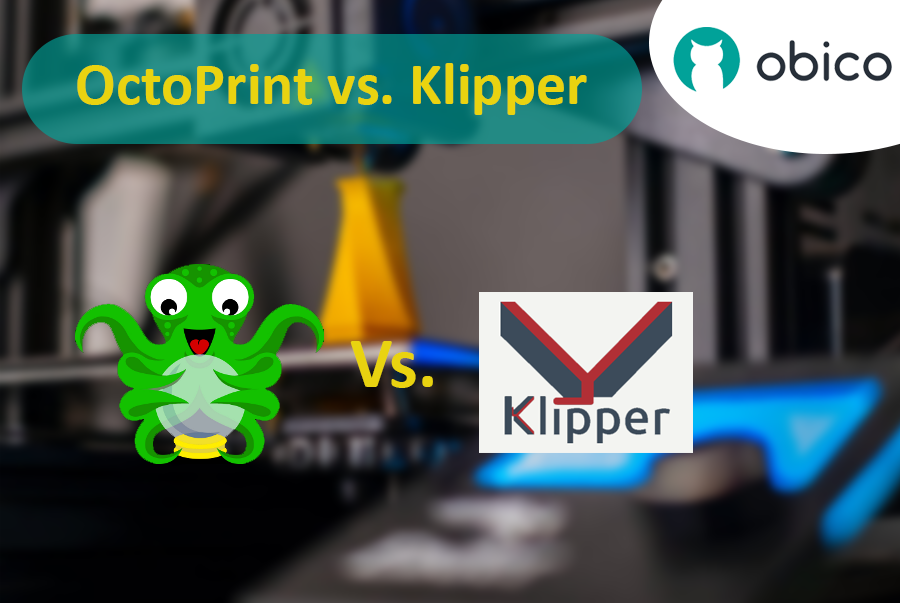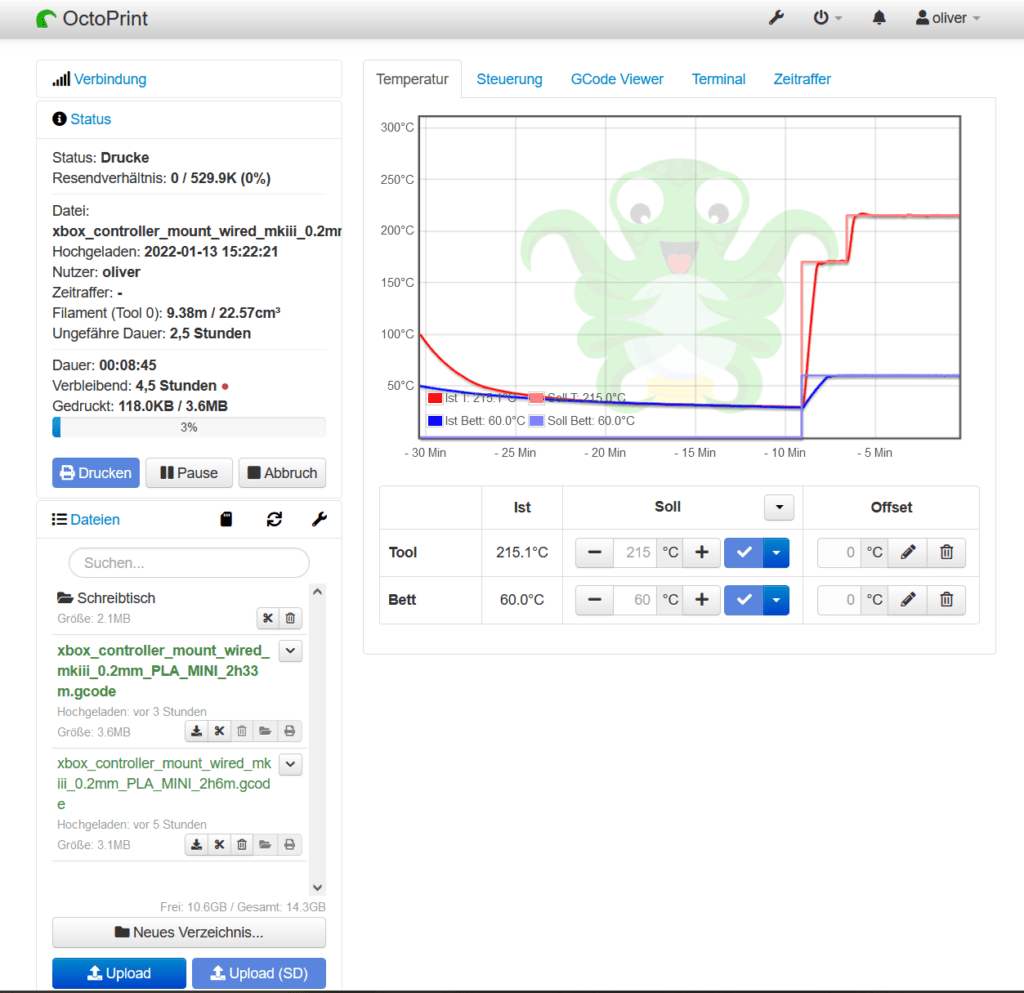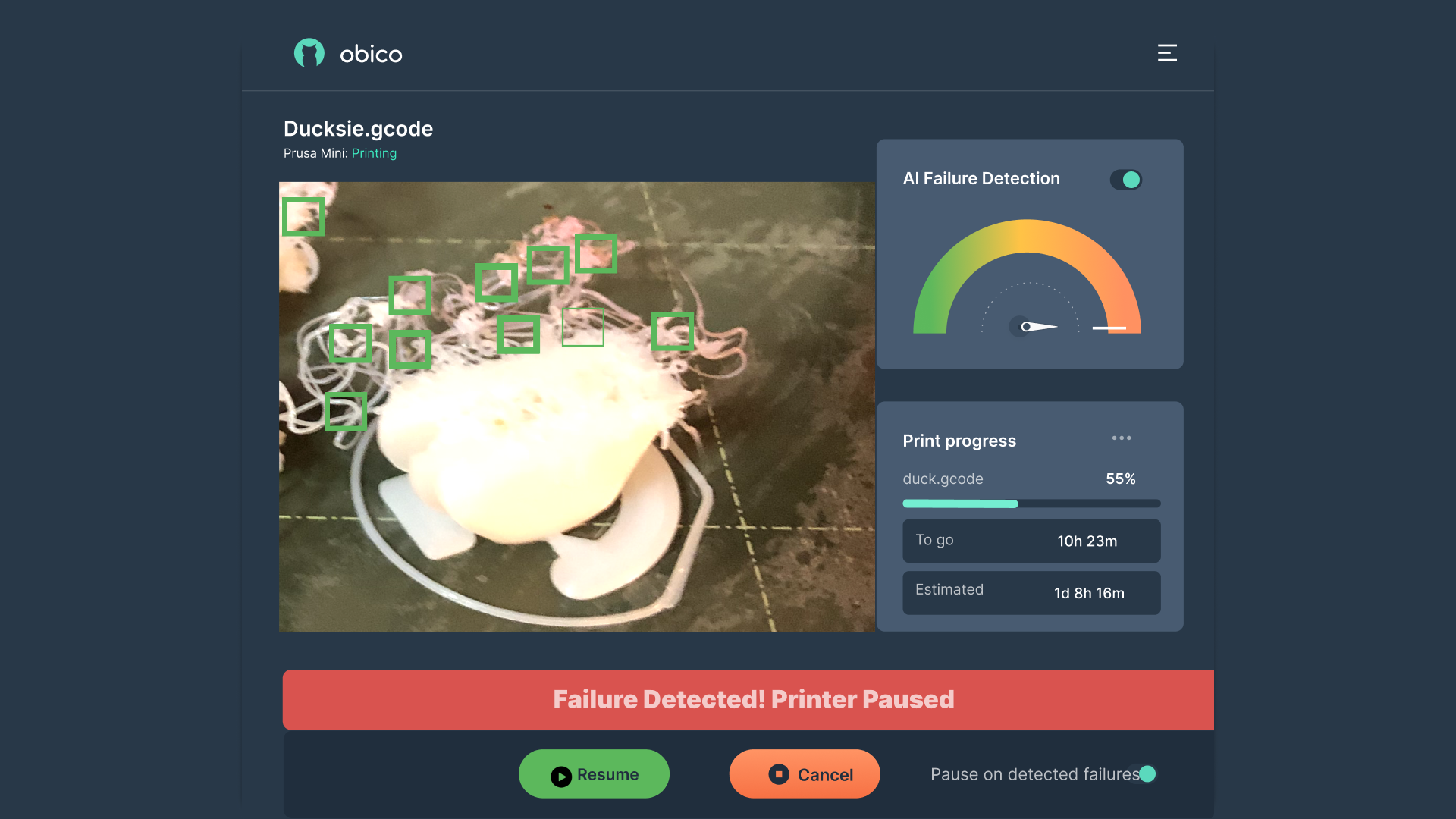OctoPrint vs. Klipper: A Comparative Analysis

Introduction
The world of 3D printing is a fascinating one, filled with endless possibilities and innovations. As 3D printing technology advances, the role of software and firmware becomes increasingly vital in achieving the best results. In this comparative analysis, we will delve into the heart of 3D printing and explore the two key players in the software and firmware arena: OctoPrint and Klipper.
Unveiling the 3D Printing Universe
Navigating the realm of 3D printing technology In recent years, 3D printing has evolved from a niche hobby to a transformative technology with applications spanning various industries. Whether you're a hobbyist, a DIY enthusiast, or a professional, 3D printing opens doors to creating objects with unprecedented precision and customization.
The pivotal role of software and firmware Behind every successful 3D print lies a carefully orchestrated symphony of software and firmware. These digital components translate your designs into physical objects, making the choice of software and firmware critical to your 3D printing experience. They control the movement of the printer's motors, the heating of the extruder, and the deposition of material layer by layer.
OctoPrint and Klipper: Two Key Players
Introducing OctoPrint and Klipper
- OctoPrint: OctoPrint is a popular web interface for 3D printers, offering a user-friendly platform for managing and monitoring your prints. It runs on a Raspberry Pi or similar single-board computer, connecting your computer or mobile device to your 3D printer through a web browser. OctoPrint boasts features like remote control, webcam integration, and a vast library of plugins to enhance your 3D printing workflow.
- Klipper: Klipper, on the other hand, is firmware designed to replace the stock firmware on your 3D printer's control board. Unlike most 3D printer firmware, which runs directly on the printer's microcontroller, Klipper operates on a separate microcontroller, such as a Raspberry Pi. This architecture allows for advanced features, precise movement control, and high-performance printing.
Their significance in enhancing the 3D printing experience OctoPrint and Klipper both play crucial roles in improving the 3D printing experience. OctoPrint offers a user-friendly interface and remote management capabilities, making it easier to monitor and control your prints. Klipper, on the other hand, provides advanced firmware features that can enhance print quality and speed. Together, they empower users to achieve better results and streamline their 3D printing workflows.
In the following sections of this comparative analysis, we will dive deeper into the intricacies of OctoPrint and Klipper, exploring their functionalities, advantages, and potential drawbacks. Additionally, we will provide a head-to-head comparison to help you make an informed choice for your 3D printing needs.
OctoPrint: An In-Depth Exploration
- OctoPrint Unveiled:
A closer look at OctoPrint
OctoPrint is a powerful and versatile web-based interface designed to facilitate 3D printing. It serves as the bridge between your computer or mobile device and your 3D printer, offering an intuitive way to control, monitor, and manage your printing processes. OctoPrint was created by Gina Häußge and has since gained a dedicated user community.

Understanding its core functionalities OctoPrint's core functionalities encompass a range of features, including but not limited to:
- Remote Control: OctoPrint allows you to start, stop, and pause prints remotely. You can also adjust print settings while your printer is in operation.
- Webcam Integration: It supports webcam integration, providing live video feeds of your prints, which is especially useful for monitoring progress and troubleshooting.
- File Management: OctoPrint helps you upload, manage, and organize your 3D printing files (G-code) conveniently.
- Plugin System: A thriving ecosystem of plugins extends OctoPrint's capabilities, allowing users to add custom features and enhancements.
- Operation and Functionality
How OctoPrint manages 3D printing processes: OctoPrint operates on a host computer or a Raspberry Pi connected to your 3D printer. It communicates with your printer's firmware, sending commands and receiving feedback, enabling precise control of the printing process. This communication occurs over USB or through a network connection, depending on your setup.
User-friendly features and interfaces: OctoPrint offers a user-friendly web interface accessible from any device with a web browser. Users can monitor print progress, adjust temperature settings, and even receive notifications on their smartphones. Its intuitive layout and real-time feedback make it accessible to both beginners and experienced users.
- Advantages and Drawbacks
Benefits of choosing OctoPrint:
- Remote Access: OctoPrint's remote access capabilities are invaluable, allowing you to manage prints from anywhere with an internet connection.
- Webcam Integration: Live video feeds provide visual feedback on prints, aiding in quality control and troubleshooting.
- Plugin Support: OctoPrint's plugin ecosystem offers a wide range of customizations, from print queue management to timelapse creation.
Potential limitations and challenges:
- Resource Intensive: Running OctoPrint on a Raspberry Pi may strain its resources, impacting performance if not properly configured.
- Dependency on Hardware: OctoPrint relies on external hardware like a Raspberry Pi, which adds to the cost and complexity.
- Real-World Applications
Who can benefit from OctoPrint? OctoPrint is suitable for a broad audience, including:
- Hobbyists: Hobbyist 3D printer users looking to enhance their printing experience and control their machines remotely.
- Professionals: Professionals who require precise control and monitoring for their 3D printing projects.
- Educators: Educators and schools using 3D printing technology for teaching purposes.
Practical applications in the 3D printing world OctoPrint finds practical use in various scenarios, such as:
- Prototyping: Rapid prototyping and iterative design with remote monitoring.
- Small-Batch Production: Managing and optimizing production of small batches of 3D-printed items.
- Education: Facilitating 3D printing education by offering remote access for students and teachers.
Klipper: A Comprehensive Examination
- Klipper Firmware: What Is It? Defining Klipper firmware Klipper is a unique and powerful firmware designed to replace the stock firmware on 3D printers. It takes a different approach compared to traditional firmware by offloading processing tasks to a host computer, typically a Raspberry Pi or similar single-board computer. This design allows Klipper to leverage the host computer's processing power, resulting in more advanced and precise control over the 3D printer's movements and processes.

Key components and its role in 3D printing Klipper firmware consists of several key components:
- Host Computer: The host computer, often a Raspberry Pi, runs the Klipper software and manages the printer's movements and operations.
- Microcontroller: The printer's original microcontroller, usually the one that came with the printer, still handles low-level tasks like heating elements and motor drivers.
- G-code Interpreter: Klipper interprets G-code commands sent from slicing software and converts them into precise motor movements and actions.
- Kinematics: Klipper's kinematics module handles the mathematics behind translating G-code into movements for various 3D printer types, including Cartesian, CoreXY, and Delta printers.
- Klipper in Action
How Klipper operates and communicates with 3D printers Klipper operates by connecting the host computer to the 3D printer's existing microcontroller. It communicates with the microcontroller over a serial connection, sending high-level commands and receiving feedback to coordinate the printer's actions. The host computer processes G-code instructions, performs complex calculations, and sends optimized commands to the printer, resulting in precise and efficient movements.
Customizability and its advantages One of Klipper's significant advantages is its high degree of customizability. Users can fine-tune and customize printer configurations, kinematics, and firmware settings to match their specific needs. This flexibility allows for experimentation and optimization, making it an attractive option for experienced users and those seeking to push the boundaries of 3D printing capabilities.
- Pros and Cons of Klipper
Analyzing the strengths of Klipper firmware
- Improved Print Quality: Klipper's advanced processing capabilities often lead to smoother and more precise print movements, improving overall print quality.
- High Speeds: It can achieve higher printing speeds while maintaining accuracy.
- Community Support: Klipper boasts an active user community and continuous development, ensuring ongoing support and enhancements.
Addressing potential challenges and complexities
- Initial Setup: Setting up Klipper may be more complex compared to traditional firmware, particularly for beginners.
- Hardware Requirements: Klipper requires additional hardware (Raspberry Pi or similar) to operate, which can add to the cost.
- Configuration Learning Curve: Customization options may be overwhelming for newcomers to 3D printing.
- The Right Fit: Klipper's Ideal Users
Identifying who should consider Klipper
-
Experienced Users: Experienced 3D printer users seeking advanced control and performance improvements.
-
Enthusiasts and Tinkerers: Those who enjoy experimenting with printer settings and pushing the boundaries of what their 3D printer can do.
Scenarios where Klipper truly shines
-
High-Speed Printing: Klipper is well-suited for scenarios where fast, accurate printing is required, such as rapid prototyping or production printing.
-
Customization Projects: Users embarking on highly customized 3D printing projects that require precise control over printer movements and dynamics.
OctoPrint vs. Klipper: Head-to-Head Comparison
- User Experience
Evaluating ease of use and setup
- OctoPrint: OctoPrint is known for its user-friendly interface and straightforward setup process. It is designed to be accessible to users of all skill levels, making it a top choice for beginners.
- Klipper: Klipper's initial setup can be more complex, especially for those new to 3D printing. It requires additional hardware (Raspberry Pi) and configuration, which might be intimidating for beginners.
Customization options and user-friendliness
- OctoPrint: OctoPrint offers a wide range of customization through plugins, making it versatile. Its interface is intuitive, and the plugin system allows users to tailor the experience to their liking.
- Klipper: Klipper excels in customization, allowing advanced users to fine-tune printer settings. However, this high degree of customization can be overwhelming for newcomers.
- Performance Metrics
Print speed and quality
- OctoPrint: Print speed and quality largely depend on the 3D printer's capabilities and the slicer settings. OctoPrint itself does not significantly impact these aspects.
- Klipper: Klipper can improve print quality and speed due to its advanced motion control. It excels in maintaining precision at higher speeds.
Resource utilization and efficiency
- OctoPrint: OctoPrint is generally lightweight and efficient, running on a Raspberry Pi or similar hardware without significant strain on resources.
- Klipper: Klipper offloads processing tasks to the host computer, potentially using more computational resources but leading to efficient and precise control of the printer's movements.
- Compatibility and Integration
Compatibility with different printers and hardware
- OctoPrint: OctoPrint is compatible with a wide range of 3D printers, making it a versatile choice. It supports various printer models and firmware configurations.
- Klipper: Klipper's compatibility depends on the printer's existing microcontroller and the effort put into configuring it. While it can work with many printers, it may require more setup and adaptation.
Extensibility through plugins and extensions
- OctoPrint: OctoPrint boasts a vast library of plugins and extensions, allowing users to extend its functionality for specific needs. This flexibility makes it a compelling choice for those seeking additional features.
- Klipper: Klipper primarily focuses on firmware and motion control. While it can be extended through custom scripting, it doesn't offer the same extensive plugin ecosystem as OctoPrint.
- Community and Support
The power of community-driven development
- OctoPrint: OctoPrint has a large and active user community. This community-driven development ensures a steady stream of updates, plugins, and support resources.
- Klipper: Klipper also benefits from a dedicated user base and active development, but it may have a smaller community compared to OctoPrint.
Availability of documentation and support resources
- OctoPrint: OctoPrint provides comprehensive documentation, tutorials, and a well-maintained forum. Users can find answers to common issues easily.
- Klipper: Klipper's documentation is thorough but may be more technical due to its advanced nature. Users might need a deeper understanding of firmware and printer configuration.
In summary, the choice between OctoPrint and Klipper depends on your specific needs and expertise. OctoPrint excels in user-friendliness and a rich plugin ecosystem, making it ideal for beginners and those seeking a straightforward 3D printing experience. Klipper, on the other hand, offers advanced motion control and customization options, making it a compelling choice for experienced users aiming to optimize print quality and speed. Consider your priorities, technical skill level, and the complexity of your 3D printing projects when making your decision.
Octoprint or Klipper Installation Guide
Now that you've gained an understanding of both OctoPrint and Klipper, as well as their differences, you're in a good position to decide which one aligns best with your needs, experience level, and budget.
If you choose to go ahead with Klipper, there's a helpful guide that can assist you in the installation process. You can find it here: Klipper Installation Guide. This guide specifically demonstrates how to set up Klipper along with Mainsail OS. Mainsail OS serves as a web interface for Klipper, enabling you to easily manage and control your 3D printer. It's important to note that while this guide is tailored for the Ender 3 3D printer, the general installation steps for Klipper are applicable to various printer models. However, you might need to tweak some configuration steps to fit your specific printer type.
On the other hand, if you decide that OctoPrint is the better fit for you, there's an excellent guide for installing this firmware too. You can access it here: OctoPrint Installation Guide. This article provides an easy-to-follow, step-by-step walkthrough on setting up Oct oPrint, making the process straightforward and user-friendly.
Both guides are designed to make the installation process as smooth as possible, helping you to get started with either OctoPrint or Klipper efficiently.
Gain Full Control and AI Monitoring with Obico from Anywhere
Obico stands out in the world of 3D printing, offering you the ability to manage your 3D printers remotely, no matter where you are. Unlike traditional setups, Obico doesn't require you to be on the same local network as your printer. It brings the future to your fingertips with its advanced AI monitoring and remote-control features.

What does Obico offer?
Benefits of Using Obico
- Remote Control Anywhere: Operate your 3D printer from any corner of the world. Stay in control whether you're in the office, at home, or on the go.
- AI-Powered Monitoring: With AI at its core, Obico identifies printing errors and filament issues in real-time, reducing waste and saving resources.
- Real-Time Printer Status Notifications: Stay informed with instant updates on your printer’s status, ensuring you’re always in the loop.
- Email Alerts: Get notified via email for critical updates or changes in your printer’s status, keeping you connected even when you’re not actively monitoring.
- Discord Integration: For the tech-savvy and community-focused, Obico offers integration with Discord, enabling alerts and updates directly through this popular platform.
- Mobile Experience: Manage your prints on-the-go with dedicated Obico apps for iOS and Android, bringing convenience to your fingertips.
- Easy Integration with OctoPrint and Klipper: Seamlessly connect Obico with OctoPrint or Klipper, enhancing their capabilities and bringing more power to your printing setup.
How to Get Started
- For OctoPrint Users: If you've chosen OctoPrint, integrating it with Obico is straightforward. Follow this easy guide to get started: OctoPrint and Obico Setup Guide.
- For Klipper Users: Chosen Klipper? No problem. You can also link it with Obico for enhanced capabilities. Here’s a detailed guide to help you: Klipper and Obico Setup Guide.
Both guides are designed to be user-friendly and detailed, ensuring a smooth setup process.
Frequently Asked Questions (FAQs)
-
What are the primary functions of OctoPrint and Klipper in the world of 3D printing?
- OctoPrint: A web-based interface that allows users to control and monitor 3D printers remotely, managing print jobs, monitoring progress, and offering customization through plugins.
- Klipper: Firmware designed to enhance 3D printing by offloading processing to a host computer, focusing on precise motion control, advanced print quality, and high-speed printing.
-
Is OctoPrint a standalone software or firmware?
- OctoPrint is standalone software that runs on a host computer, like a Raspberry Pi, and connects to 3D printers for print management.
-
Can OctoPrint and Klipper be used in conjunction on the same 3D printer?
- Yes, OctoPrint and Klipper can be used together for managing print jobs and providing user interface while Klipper handles firmware and precise motion control.
-
For beginners, which is more suitable: OctoPrint or Klipper?
- OctoPrint is more suitable for beginners due to its user-friendly interface and ease of setup. Klipper, with its customization options, may be better suited for experienced users.
-
Do OctoPrint and Klipper support all 3D printer models?
- OctoPrint supports a wide range of 3D printer models and firmware configurations. Klipper's compatibility varies based on printer hardware and configuration efforts.
-
Are there any safety concerns associated with using Klipper firmware?
- Klipper firmware itself doesn't introduce specific safety concerns, but standard 3D printer safety practices should be followed, especially when customizing settings that affect hardware.
-
Could you highlight some popular OctoPrint plugins and how they enhance the 3D printing experience?
- Popular plugins include "OctoLapse" for time-lapse videos and "Printoid" for mobile control, enhancing functionality and convenience.
-
Is it possible to switch from OctoPrint to Klipper, or vice versa, after initial setup?
- Yes, switching is possible but involves reconfiguring the 3D printer and adjusting settings to suit the chosen software or firmware.
-
How can users determine whether OctoPrint or Klipper is the right choice for their specific needs?
- Consider experience level, desired features, and technical goals. OctoPrint is user-friendly and suited for remote management, while Klipper offers advanced motion control and customization.
-
Are there alternative software or firmware options available for 3D printing?
- Yes, alternatives like Repetier-Host, PrusaSlicer, Marlin firmware, and Duet firmware are available, each with unique features and capabilities. The choice depends on specific requirements and preferences.
Conclusion
Choosing between OctoPrint and Klipper for your 3D printing setup is a significant decision that depends on your specific needs, preferences, and level of expertise. Each of these tools offers unique advantages and features that cater to different aspects of the 3D printing process. Here are some key takeaways and considerations to help you make an informed decision:
-
OctoPrint is an excellent choice if you:
- Are a beginner or prefer a user-friendly interface.
- Need remote access and control over your 3D printer.
- Want access to a wide range of plugins for added functionality.
- Value a strong and active user community for support and resources.
-
Klipper may be the right fit if you:
- Are an experienced user looking to optimize print quality and speed.
- Are comfortable with hardware setup and firmware configuration.
- Require precise motion control and are interested in customization.
- Have a 3D printer capable of leveraging Klipper's advanced features.
Key Takeaways:
- Consider Your Expertise: Your experience level plays a crucial role in the choice between OctoPrint and Klipper. OctoPrint is beginner-friendly, while Klipper offers advanced customization for experienced users.
- Prioritize Your Needs: Identify your specific requirements. Do you need remote monitoring and ease of use (OctoPrint), or are you more focused on print quality and performance optimization (Klipper)?
- Hardware and Compatibility: Ensure that your 3D printer's hardware is compatible with your chosen software or firmware. Both OctoPrint and Klipper have compatibility requirements to consider.
- Customization vs. Convenience: OctoPrint offers convenience through plugins, while Klipper provides extensive customization options. Choose based on your preference for flexibility or simplicity.
- Community and Support: Both OctoPrint and Klipper benefit from active user communities. Explore available resources and forums for assistance.
- Safety First: Regardless of your choice, always follow safety guidelines and best practices when working with 3D printers to ensure safe and reliable operation.
In conclusion, the decision between OctoPrint and Klipper should align with your goals and familiarity with 3D printing technology. Whichever option you choose, both OctoPrint and Klipper have their strengths and can greatly enhance your 3D printing experience. Remember to explore the documentation, forums, and user communities to make the most of your chosen tool and enjoy your 3D printing journey to the fullest.
